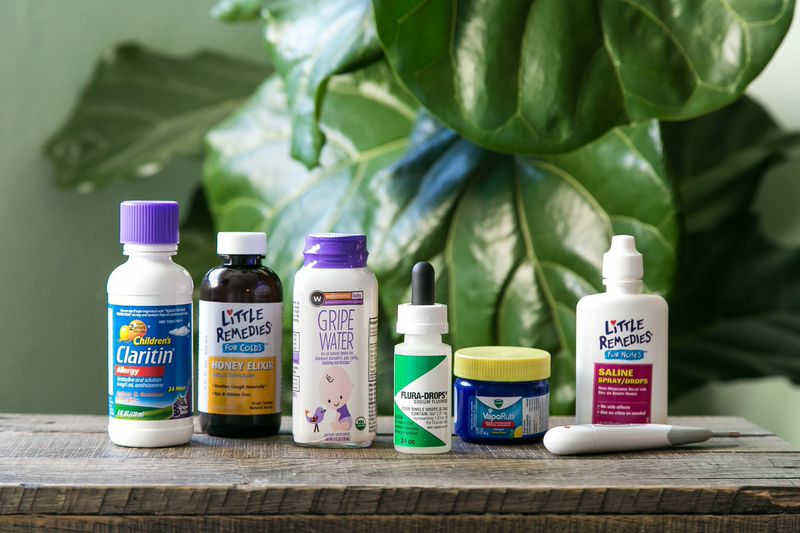
How To Stock A Kid-Friendly Medicine Cabinet
Written by JUDY KIVOWITZ
Photography by Photographed by Tara Rudolph
The seen-it-all, treated-it-all Nurse Judy Kivowitz of San Francisco’s Noe Valley Pediatrics shares her advice on common child health and behavioral conundrums.
If you or your child becomes ill in the middle of the night, that 3 a.m. visit to Walgreens may furnish you with some interesting anecdotes, but generally it is something you want to avoid. Instead, stock your medicine cabinet correctly ahead of time with these tips below to avoid late-night chaos. Here, a quick-reference guide.
Oral Meds For Fever & Pain Relief
–Acetaminophen and Ibuprofen are the most common medications for fever reduction/pain relief.
-Remember that you never want to give actual Aspirin to a child.
–Acetaminophen/Tylenol now has a fairly new infant label. It is the same concentration as the children’s, so they are actually interchangeable, but the infant bottle comes with a nifty little measuring system and a spill-proof bottle, which is safer.
-Acetaminophen also comes as a suppository, which is great for a child who is vomiting or resisting medication by mouth.
-Ibuprofen is also known as Advil or Motrin. This medicine comes in a more concentrated infant dropper. Make sure you understand your child’s proper dose
Antihistamines
–Benedryl and Zyrtec are the antihistamines we most commonly use. These would be given for allergic reactions, itchy skin, rashes, or insect bites.
-Benedryl will make many kids (and adults) very sleepy.
-The generic name for Benedryl is Diphenhydramine HCL. There is no special liquid for infants. Most of the bottles have a caution not to use for children under 4. In our office, we do use it for younger patients, if indicated. Don’t give it to a young child without speaking to your health care provider.
–Zyrtec (Cetirizine) also comes in a liquid. It is supposed to be non-sedating, but if you are an adult, I would test that out before taking it and driving. It makes me sleepy.
-They are both worth having on hand.
Dehydration
-Both Pedialyte and Drip Drop are oral rehydration solutions that would be used if your child is vomiting.
-Breast milk is also great for that, but not everyone is lucky enough to always have it on hand.
–Pedialyte is the one you most likely have heard of. Unfortunately, it tastes a bit like soap. The company claims to have recently made it a bit more palatable. It also comes in popsicle form, which is great for older kids.
–Drip Drop is new on the market and tastes a bit better. Some Walgreens stores carry it, but alas, it is not always easy to find. This is where planning ahead will help you out. You can get it from Amazon. It comes as a powder that you mix with water (this stuff is very handy for traveling).
Topical Creams
-Stock your cabinet with triple antibiotic ointment for cuts or scratches, anti-fungal cream for yeasty rashes or fungal infections, arnica for bruises, and OTC hydrocortisone cream for mild itchy irritations.
-It is easy for tubes of ointments to get contaminated. Think about it. If the tip comes in contact with bacteria from a finger or directly from the body, there you go. Yuck! One study that I read suggested that more than half of the tubes of creams and ointments that people have laying around are contaminated with Staph. The best way to avoid this is to make sure that you don’t directly touch the tip to anything. Try to keep it sterile. Squeeze the desired amount onto a spoon and then use whatever applicator you want (clean fingers are usually fine).
Other Considerations
-You also want to make sure you have some basic first-aid supplies, like band-aids and gauze, in your cabinet.
-If your child is prone to constipation, make sure you have Pedialax (glycerin suppositories) on hand.
-If you child is prone to mouth sores or irritations, I find Glyoxide very helpful and healing.
-If you child has a history of wheezing, now is the time to make sure you have asthma medications available. Please check the expiration date and see when they were opened. Many of those are light sensitive, so you should always mark the package when you open them.
-If your child uses a nebulizer, the tubing should be replaced every 6 months.
-If you or your child use an inhaler, it should be rinsed out at least once a week. If it hasn’t been used for more than a week, it may need to be primed. Check the directions on your specific medication. Pro Air, which is one of the more popular inhalers, needs to have 3 extra puffs to clear it if it hasn’t been used in 2 weeks.
-Make sure that all your medications are stored in a safe, child-proof location (a steamy bathroom is not the best place). Don’t underestimate the ability of a climbing child who knows where the gummy vitamins or yummy medicine is stashed.
-Have a working thermometer that you have tested for accuracy before someone actually has a fever. As long as your baby is over 2 months, I am not one who is going to focus too much on the exact degree of the fever, but we do want to get a sense of how high it is. (Get more Nurse Judy tips on fevers here!)
-With any of your medications, put a strip of masking tape on the side of the open bottle and sign and date your doses. This will avoid the common incident of parents double dosing their babies. This also will help you keep track for yourself when you are sleep deprived. I get plenty of frantic calls from parents who have inadvertently overdosed their kids by giving the medications too often. If there is a concern your first call should be to Poison Control.
Expired Meds
-Do a routine check for expired medications.
-Don’t randomly toss expired medication down the drain or flush it in the toilet. Medicine can pollute the bay and ocean, or be accidentally misused or abused. Waste-water treatment plants are not designed to remove medications or other chemicals in waste water, so after traveling down your drain, medicine may affect our environment. There used to be special days where you could drop off your expired meds, but they are no longer needed because there are currently ongoing programs. Research a local spot that takes expired meds.
-When disposing of meds, mix pills in a ziplock bag or in as few containers as possible.
-Tighten the lids of liquid medicines or place the entire bottle in a ziplock bag.
-Controlled substances (ex: Vicodin, OxyContin, Ritalin, Adderall, or Valium) are only accepted at police stations.
-When you visit one of the pharmacy sites, simply deposit your medicine in the green drop-box. If you visit a police station, take your medicine directly to the window. At police stations, you may be asked for your name and address. You are free to decline to give them that information.
Find out how to sign up for Nurse Judy’s San Francisco-based classes and workshops here.
Share this story




